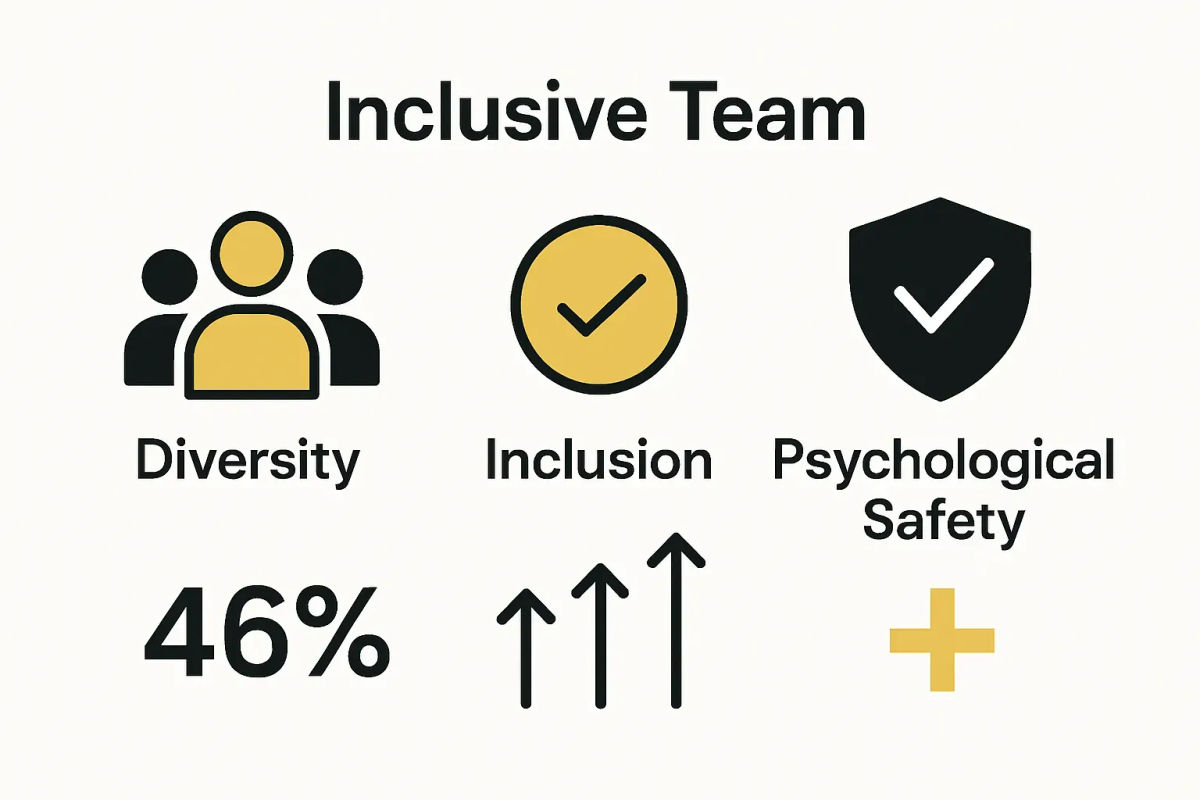Understanding What is Inclusive Team Building
October 7, 2025

Inclusive team building is changing how organizations think about collaboration by making sure every voice is valued. You might assume this is just about fairness or meeting quotas but companies with diverse leadership are actually 35 percent more likely to outperform their competitors financially. That kind of impact isn’t about checking a box with diversity programs. It is about building real connections and unlocking strengths many teams leave untapped.
Table of Contents
- Defining Inclusive Team Building: What Is It?
- The Importance Of Inclusivity In Teams
- Key Principles Of Inclusive Team Building
- How Inclusivity Enhances Team Performance
- Real-World Examples Of Inclusive Team Building
Quick Summary
| Takeaway | Explanation |
|---|---|
| Inclusive team building fosters belonging | Creating environments where everyone feels valued enhances team dynamics and collaboration. |
| Diversity drives innovation | Teams with varied backgrounds create creative solutions that outperform homogeneous teams. |
| Psychological safety is essential | Team members need to feel secure expressing ideas without fear of judgment for optimal collaboration. |
| Ongoing learning is crucial | Continuous improvement in inclusive practices is necessary to adapt to changing workplace dynamics. |
| Challenge biases consciously | Actively addressing unconscious biases promotes equitable participation and enhances team performance. |
Defining Inclusive Team Building: What Is It?
Inclusive team building represents a strategic approach to organizational development that intentionally creates environments where every team member feels valued, respected, and empowered to contribute regardless of their background, identity, or personal characteristics. Unlike traditional team building methods that might inadvertently marginalize certain individuals, inclusive team building actively recognizes and celebrates diversity while fostering genuine connections.
Core Principles of Inclusive Team Building
At its foundation, what is inclusive team building really about? It goes beyond surface-level interactions and delves into creating psychological safety where individuals from all walks of life can authentically engage. According to Cornell University's Diversity and Inclusion Research, inclusive environments dramatically improve team performance and employee satisfaction.
The core principles include:
- Acknowledging Individual Differences: Recognizing that each team member brings unique perspectives, experiences, and skills.
- Creating Equitable Participation: Designing activities and interactions that provide equal opportunities for contribution.
- Challenging Unconscious Biases: Systematically identifying and addressing hidden prejudices that might limit team dynamics.
Why Inclusive Team Building Matters
Inclusive team building is not just a moral imperative but a strategic organizational necessity. Research demonstrates that diverse and inclusive teams are more innovative, make better decisions, and consistently outperform homogeneous groups. McKinsey's Diversity Report reveals that companies with diverse leadership are 35% more likely to have financial returns above their industry median.
By embracing inclusive team building practices, organizations can create environments where psychological safety flourishes, communication becomes more transparent, and collective potential is genuinely unleashed.
To help clarify the core principles of inclusive team building, the following table summarizes each principle and its purpose.
| Principle | Description |
|---|---|
| Acknowledging Individual Differences | Recognizing each team member brings unique perspectives, experiences, and skills. |
| Creating Equitable Participation | Ensuring everyone has equal opportunities to contribute and engage. |
| Challenging Unconscious Biases | Actively identifying and addressing hidden biases that limit team dynamics. |
| Establishing Clear Goals | Setting specific diversity and inclusion objectives to guide team development. |
| Transparent Communication | Providing open channels for feedback and sharing of ideas. |
| Psychological Safety | Creating an environment where members feel safe expressing themselves. |
| Continuous Learning | Committing to ongoing improvement of inclusive practices and adaptability. |
The Importance of Inclusivity in Teams
Inclusive team environments are not merely a modern workplace trend but a fundamental requirement for organizational success. When teams truly embrace diversity and create spaces where every member feels genuinely valued, extraordinary outcomes emerge. The significance of inclusivity transcends mere demographic representation and delves into creating psychological environments that unlock collective potential.
Driving Innovation Through Diverse Perspectives
Diversity is a powerful catalyst for innovation. Teams with varied backgrounds bring multifaceted problem solving approaches that homogeneous groups cannot replicate.
McKinsey's global research indicates that companies with diverse teams are 35% more likely to generate above average financial returns. This statistic underscores how inclusivity is not just a moral imperative but a strategic business advantage.
Key benefits of inclusive team environments include:
- Expanded creative problem solving capabilities
- Enhanced employee engagement and satisfaction
- Improved decision making through multiple viewpoints
Psychological Safety and Team Performance
Inclusive teams create psychological safety where team members feel comfortable expressing unique ideas without fear of judgment. This safety enables genuine collaboration, reduces communication barriers, and promotes a culture of mutual respect.
Here is a comparison of how inclusive and traditional team building approaches differ, highlighting the unique benefits and practices of each.
| Aspect | Traditional Team Building | Inclusive Team Building |
|---|---|---|
| Focus | General team bonding | Fostering belonging and valuing diversity |
| Participation | May leave some voices unheard | Designed for equitable participation |
| Addressing Bias | Rarely addressed | Actively recognizes and challenges unconscious biases |
| Innovation Impact | Limited by groupthink | Drives creativity through diverse perspectives |
| Psychological Safety | Not always prioritized | Explicitly creates a safe space for all voices |
| Ongoing Learning | Often a one-time event | Emphasizes continuous improvement |
Moreover, inclusive teams demonstrate remarkable resilience. By integrating diverse perspectives, organizations can navigate complex challenges more effectively. Learn more about building team cohesion to understand how diverse teams transform workplace dynamics.
Ultimately, inclusivity represents more than a strategic approach it embodies a fundamental human respect that recognizes every individual's intrinsic worth and potential. By championing inclusive team practices, organizations do not just improve performance they create environments where human potential can truly flourish.
Key Principles of Inclusive Team Building
Inclusive team building requires a strategic and intentional approach that goes beyond superficial diversity metrics. It demands a comprehensive framework that systematically addresses organizational culture, communication patterns, and individual experiences. The goal is to create an environment where every team member can fully engage, contribute, and thrive.
Foundational Principles of Inclusivity
Representation matters, but true inclusivity requires depth and authenticity. Centers for Disease Control research highlights the importance of structured approaches to reducing systemic barriers. The foundational principles include creating environments that actively recognize and value individual differences while promoting equitable opportunities.

Key structural elements include:
- Establishing clear diversity and inclusion goals
- Developing transparent evaluation and advancement processes
- Creating multiple channels for feedback and communication
Psychological Safety and Empowerment
At the heart of inclusive team building lies psychological safety. This principle ensures team members feel secure expressing their unique perspectives without fear of marginalization or professional repercussions. Psychological safety transforms workplace dynamics by encouraging authentic communication, vulnerability, and collaborative problem solving.
This approach requires leaders to:
- Model inclusive behaviors
- Actively listen to diverse perspectives
- Challenge unconscious biases systematically
Continuous Learning and Adaptation
Inclusive team building is not a destination but an ongoing journey of learning and growth. Organizations must remain committed to continuous improvement, regularly reassessing their practices and adapting to evolving workplace dynamics. Explore strategies for defining team building success to enhance your organizational approach.
Successful inclusive team building ultimately transcends checklist compliance. It represents a profound commitment to recognizing human potential, celebrating individual uniqueness, and creating environments where collective excellence can genuinely emerge.
How Inclusivity Enhances Team Performance
Inclusive team environments transform traditional workplace dynamics by unlocking collective potential through genuine engagement and respect. Performance is not merely about individual capabilities but about creating synergistic interactions where diverse perspectives converge to generate extraordinary outcomes. This approach fundamentally reimagines how teams collaborate and innovate.
Cognitive Diversity and Problem Solving
Cognitive diversity represents the fundamental mechanism through which inclusive teams generate superior performance. When team members with different backgrounds, experiences, and thinking styles collaborate, they create a robust problem solving ecosystem. Harvard Business Review research demonstrates that inclusive teams approach challenges with multifaceted perspectives, leading to more comprehensive and innovative solutions.
Key performance enhancements include:
- Accelerated creative problem solving
- Reduced likelihood of groupthink
- Enhanced adaptability to complex challenges
Psychological Safety and Collaborative Intelligence
Psychological safety transforms team dynamics by creating an environment where members feel secure expressing unconventional ideas. This safety mechanism enables teams to leverage collective intelligence more effectively. When individuals sense their contributions are valued, they become more willing to share insights, challenge assumptions, and collaborate authentically.
Teams benefit through:
- Increased intellectual risk taking
- More transparent communication
- Deeper mutual understanding
Measuring Inclusive Performance Impact
Quantifying the impact of inclusivity requires looking beyond traditional metrics. Performance is not just about numerical outcomes but about creating environments where human potential can genuinely flourish.
 Explore strategies for promoting effective teamwork to understand how inclusive approaches drive organizational success.
Explore strategies for promoting effective teamwork to understand how inclusive approaches drive organizational success.
Ultimately, inclusive team performance represents a holistic approach that recognizes human complexity. By championing diversity, organizations do not simply improve operational efficiency they create ecosystems where innovation, respect, and collective potential can truly thrive.
Real-World Examples of Inclusive Team Building
Inclusive team building moves beyond theoretical concepts into practical applications that transform organizational culture. These real world strategies demonstrate how companies can create environments where diversity is not just acknowledged but actively celebrated and leveraged as a competitive advantage.
Technology Sector Innovations
Tech companies have been at the forefront of developing innovative inclusive team building approaches. Pioneering organizations recognize that diverse teams drive technological innovation. Google's Project Aristotle extensively researched team dynamics and discovered that psychological safety and inclusive practices were more critical to team success than individual brilliance.
Successful approaches include:
- Creating cross functional project teams
- Implementing mentorship programs targeting underrepresented groups
- Developing transparent promotion and evaluation frameworks
Corporate Cultural Transformation
Progressive organizations are reimagining team building as a holistic cultural strategy. Companies like Salesforce have implemented comprehensive inclusion programs that go beyond traditional diversity metrics. These approaches focus on creating genuine belonging, where every team member feels valued and empowered to contribute their unique perspectives.
Key transformation strategies involve:
- Regular unconscious bias training
- Employee resource groups
- Leadership accountability for inclusive practices
Learning and Development Initiatives
Inclusive team building is an ongoing journey of organizational learning and adaptation. By consistently investing in programs that promote understanding and collaboration, companies create resilient, innovative teams. Discover team building activities that boost morale to understand practical approaches to fostering inclusive environments.
These real world examples demonstrate that inclusive team building is not a checkbox exercise but a profound commitment to recognizing human potential. Organizations that genuinely embrace these principles do not just improve team performance they fundamentally transform workplace culture.
Turn Inclusive Team Building Principles Into Real Engagement
Recognizing that real inclusivity goes far beyond checklists is one thing. Sparking authentic connection and belonging for every team member is another. If you have ever struggled with dated team activities, unequal participation, or a lack of psychological safety, you know how quickly these problems drain motivation and productivity. This article explored psychological safety, cognitive diversity, and the need for engaging environments where every voice matters. But how do you put these inclusive concepts into action?

Make inclusion come alive for your team today through customizable quiz game experiences that do more than entertain. Use Quizado to create interactive sessions where all team members participate equally, share their views safely, and celebrate what makes them unique. Whether online or in person, you can configure teams, add your own branding, install on any device, and use a rich bank of questions for instant variety. Learn how team-building activities can boost morale and see for yourself why playful learning is your best tool for real inclusion. Visit Quizado.com now and start building an inclusive culture where everyone feels valued.
Frequently Asked Questions
What is inclusive team building?
Inclusive team building is a strategic approach that creates environments where every team member feels valued, respected, and empowered to contribute, regardless of their background or identity.
Why is inclusivity important in team building?
Inclusivity enhances team performance by fostering diverse perspectives, driving innovation, and creating psychological safety, which improves collaboration and engagement among team members.
How can organizations promote inclusive team building?
Organizations can promote inclusive team building by establishing clear diversity and inclusion goals, creating equitable participation opportunities, providing unconscious bias training, and encouraging open communication.
What are the core principles of inclusive team building?
The core principles include acknowledging individual differences, creating equitable participation, and challenging unconscious biases to build a supportive organizational culture.



